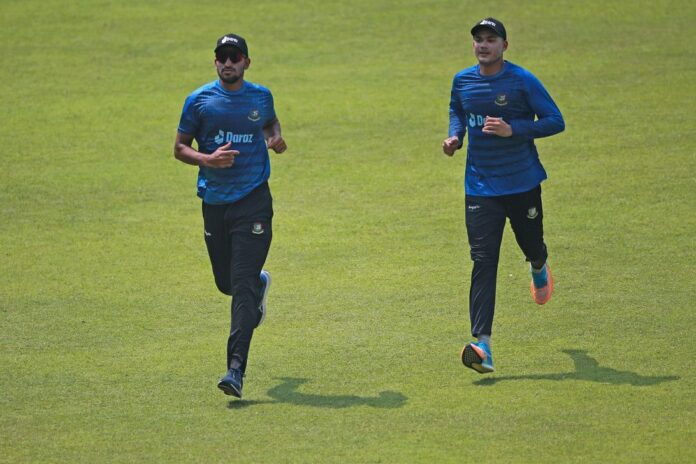Photo: Firoz Ahmed
“Bhai, don’t say anything,” one cricketer requested as he and a few members of the national team came off their running exercise, sensing that the query was regarding the intense weather.
Fatigue was vividly written across his face. The weather has been intense for the past week and yesterday afternoon, it ‘felt’ like 47 degrees. In this intense heat, load management will be key for the BCB and they felt that the changes they were making would make a difference.
“We will have to play a Test match in this weather so it is about preparing,” selector Habibul Bashar told The Daily Star.
Heading to a World Cup and given the heat, managing the pacers’ workload is pivotal. So how does the BCB’s current load management system work?
“It’s a software-based program. Either the players or the ones supervising them inputs the data. It is especially used for pace bowlers. It has existed for a number of years but the software has been updated. We input the number of overs a bowler has sent down in a day. The basic rule we use is the seven-four-two rule. It means in seven days, you can bowl four days and you can’t bowl for more than two days on the trot,” BCB chief physician Debashish Chowdhury told The Daily Star.
Red and green are the colour codes used, with red suggesting a player has either exceeded his workload or has had an inadequate workload within a given timeframe while green means a player has fulfilled their optimal number of overs before a match.
Taskin, who is still in recovery mode following an injury, had not bowled a day before yesterday, in accordance with the seven-four-two rule. Will the same standards be used for every player?
“Yes, it is a standardised system so it is the same for everyone irrespective of age, height, weight. The seven-four-two rule is just a guideline. It can be used loosely during tournaments,” Debashish informed. “We have Players of National Interest (PONI), who are under the umbrella of load management,” he added.
Taskin was included in the squad for the one-off Test against Afghanistan on June 14, but he will now need to meet a certain workload before being declared fully ready.
“If you have to bowl in a Test, you have to carry a certain workload. If you don’t have the optimal numbers, you could be in trouble. If the workload is high, there is also a risk. Taskin is fully fit medically, but he has not had enough of a workload and bowled optimally, so maybe he won’t reach optimum numbers before the Afghanistan Test. There could be a risk but the coach is there to take the decision on his inclusion,” Debashish said.
GPS trackers are being introduced from the Afghanistan series. “It is also a load management tool, used to see how much a player is moving. We haven’t used it before. We have foreign staff who are overseeing these technologies. Due to that, we are also ensuring our own staff is not being overworked. We didn’t have these documentations like Australia or England did before,” he added.
What remains to be seen now is whether Taskin reaches his optimal workload requirement. He had been sought out to play the County Championship season for Yorkshire County but did not want to go, BCB cricket operations chairman Jalal Yunus informed yesterday. “He was talking to us but with the World Cup coming up, both parties decided it would be better not to play for now,” Jalal said.
“Yes, it was done with workload in mind. They have four-day and one-dayers which are very taxing. It would be too demanding,” Bashar felt.
Taskin is the pace spearhead and managing his load can prove pivotal. As the BCB gains more of a foothold in managing this system, efficiency increases.



